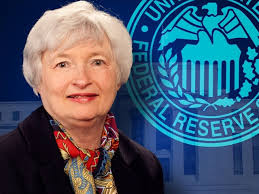
Last night, Janet Yellen who heads the Federal Reserve’s Open Market Committee, brought to an end an era of zero interest rates.
The decision to increase the target range for the Fed Funds rate from 0.25% to 0.50% was expected by market participants.
However, after a period of 7 years of static interest rates, it was important that the Fed Chair Woman made sure that the language of the speech that accompanied the announcement was correct.
Mrs. Yellen sighted an improvement in the labour market, improvements in GDP and even a pick up in the automobile sector as factors that influenced unanimity with the FOMC to increase interest rates at the December meeting.
The Federal Reserve Chairwoman’s speech could be seen as cautious with this rate increase categorized as being a dovish hike.
This dovishness and cautious approach were highlighted by a number of times Mrs. Yellen used the word “gradual” in her speech.
A gradual approach would indicate a policy of increase now, ascertain the consequences and decide what is next.
This is in contrast to a “measured” policy where the Fed Funds rate will rise at each meeting.
The Federal Reserve, according to the statement, forecasted the medium term projection late 2016 1.5%.
Further out in late 2017, the FOMC placed the Fed Funds rate at 2.5%.
If we assume that the Federal Reserve will stick to a 25 basis point incremental increases, then this means that we should see 4 increases through the course of 2016.
The FOMC decided to act now because there are concerns that delay would only cause problems down the line.
Future timing on interest increase is, of course, all down to inflation expectations and what the FOMC receives in terms on incoming data.
Therefore monitoring the progress of the US economy and the move to the inflation goal of 2% will mean that the FOMC will continue to be data dependent.
On the one hand, Janet Yellen wants to see evidence that future inflation will move towards the target by monitoring the incoming trend in data.
However at the same time, the FOMC like all central banks is reliant on inflation forecasting to help it gauge the timing of subsequent rate increases.
This is where it gets a bit tricky as relying on forecasts does not always mean you make the right decision as these forecasts can be wrong.
To a certain degree, the FOMC is hoping that inflation will move towards the target and future jobs reports will continue to trend in the right direction. However, these assumptions are far from certain.
Commodity prices falling and the price of crude oil could come under more pressure as Iran begins to increase its own production thus stoking deflation.
Then we have the fear of the unknown such as economic and political shocks that could derail the FOMC’s best-laid plans.
Looking a bit further out, the current recovery has been supported by low-interest rates. The US economy has grown during the current business cycle. This recovery has been slow therefore it is possible that that this positive business cycle lasts beyond 2017 and up to 2020.
However, there is always a worry that the current cycle could end due to an unforeseen shock. With the current business cycle going through its latter stages, the possibility that a shock that brings the US economy back into recession should not be discounted.
To end, it would seem that the FOMC launched its QE programme without a plan. The concern is the era of low-interest rates and QE will also end without a real plan.
